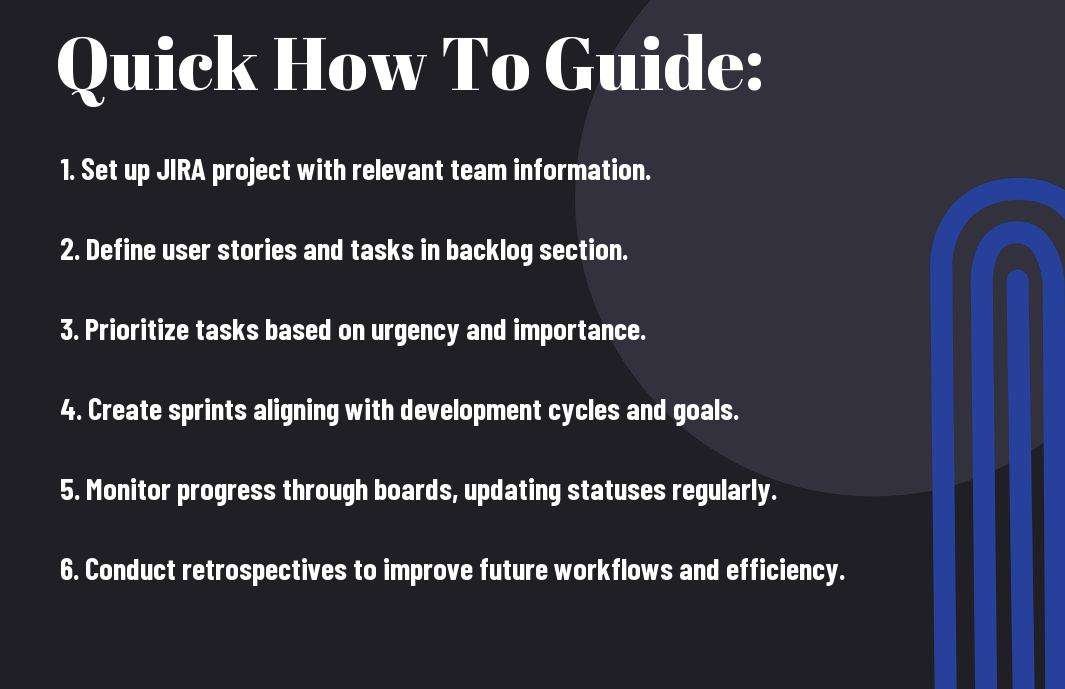Just knowing how to use JIRA effectively can transform your Agile product development process. In this post, I’ll guide you through the features and best practices that will help you streamline your workflow and enhance team collaboration. You’ll learn how to set up your JIRA boards, manage tasks, and track progress seamlessly. By the end, you’ll have the tools you need to ensure productive sprints and smoother project management. Let’s unlock the potential of JIRA together!
Key Takeaways:
- Streamlined Task Management: Utilize JIRA to efficiently organize and prioritize tasks within your Agile team, ensuring everyone is aligned with project goals.
- Enhanced Collaboration: Leverage JIRA’s collaborative features to improve communication among team members, promoting a seamless workflow and quicker resolution of issues.
- Data-Driven Insights: Make use of JIRA’s reporting tools to analyze project progress and team performance, allowing for informed decision-making and continuous improvement.
Understanding JIRA in Agile Development
Your journey into Agile product development is incomplete without a solid understanding of JIRA. As a tool designed to enhance productivity, JIRA helps teams effectively manage tasks, track progress, and ensure alignment with Agile principles. By using JIRA, you can foster better collaboration, maintain transparency, and streamline workflow processes vital for successful Agile projects.
What is JIRA?
Little is more powerful in project management than JIRA, a tool developed by Atlassian specifically for tracking issues and managing Agile development projects. It is designed to cater to teams employing various Agile methodologies, providing unique functionalities that enable users to create, assign, prioritize, and track tasks seamlessly throughout the project lifecycle.
The Role of JIRA in Agile Methodologies
There’s no denying that JIRA plays an integral role in facilitating Agile methodologies. It serves as the backbone of Agile project management, allowing you to maintain an organized structure while promoting flexibility. By leveraging its capabilities, you can create and manage backlogs, sprints, and epics, ensuring that your team stays focused on delivering value.
Agile methodologies thrive on collaboration, adaptability, and continuous improvement, and JIRA embodies these principles. It enables you to visualize progress through boards, monitor team performance via reports, and ensure transparent communication among stakeholders. This dedicated platform allows for easy prioritization of tasks, so you can concentrate on delivering the most valuable features to your users while maintaining a full overview of your project’s status. By embracing JIRA, you’re equipping yourself and your team with the tools necessary for Agile success.
How to Set Up JIRA for Your Team
One of the first steps to optimize your agile product development is to set up JIRA appropriately for your team. I recommend starting with an understanding of Agile Workflows: Steps and Best Practices. This insight will guide you through tailoring JIRA’s features to your team’s specific workflow needs, ensuring transparency and efficiency in your project management.
Creating Projects in JIRA
Your initial step in JIRA involves creating projects that reflect your team’s structure and objectives. It’s vital to choose project types that align with your workflow, such as Scrum or Kanban, enabling you to manage tasks effectively and track progress seamlessly.
Configuring Agile Boards
Boards are vital in JIRA as they provide visual representations of your team’s workflow. Proper configuration enables you to manage and prioritize tasks effectively, enhancing the collaboration within your team.
Plus, you can customize your boards by setting up columns that reflect your workflow stages, making it easier for your team to visualize progress. Ensure that any filters or swimlanes you use are catered to your team’s needs, as this can significantly impact productivity. By doing so, you enhance communication and keep everyone focused on delivering value to your customers.
Tips for Efficient Workflows in JIRA
Despite the complexities inherent in Agile product development, you can streamline your processes in JIRA with the right strategies. Here are some tips to maximize your workflow:
- Define clear issues and sub-tasks
- Use Agile boards for better visibility
- Set up automated notifications for updates
- Regularly conduct retrospectives to improve
After implementing these strategies, you can significantly enhance your team’s productivity.
Customizing Workflows
Efficient workflows in JIRA can be achieved through careful customization. By tailoring your workflows to fit your team’s specific needs, you can avoid unnecessary steps and streamline processes. This involves setting statuses that reflect your project’s phases and adjusting transition rules, which helps in reducing confusion and aids in smoother collaboration.
Utilizing JIRA Filters and Queries
Efficient use of filters and queries in JIRA can enhance your team’s focus on high-priority tasks. By creating customized filters, you can quickly access relevant issues and track progress without sifting through irrelevant data.
Utilizing JIRA filters and queries allows you to create specific views tailored to your needs, promoting better organization and facilitating more effective collaboration. You can save filter queries for easy access, minimizing the time spent searching for specific information. Moreover, employing JIRA Query Language (JQL) provides powerful capabilities to sift through large datasets. This helps in pinpointing blockers or urgent tasks while avoiding distractions from less relevant issues.
Managing Backlogs Effectively
Unlike traditional project management tools, JIRA allows for a streamlined approach to managing backlogs in an agile environment. By categorizing tasks and user stories directly related to your project goals, you can ensure that your team focuses on the right priorities, enhancing overall efficiency and productivity.
Organizing User Stories and Tasks
Assuming you’ve gathered your user stories, it’s crucial to organize them into well-defined categories. Using JIRA’s features, I recommend creating epics to group related user stories and using labels or components for additional categorization. This structure not only provides clarity but also helps team members quickly understand the workload at hand.
Prioritizing with JIRA’s Backlog Feature
You can leverage JIRA’s backlog feature to prioritize tasks effectively. By using a visual tool, I can rank user stories based on their importance and the value they add to the project, ensuring the team is always focused on high-impact work.
Understanding the power of JIRA’s backlog feature is crucial for successful agile product development. By prioritizing user stories and tasks effectively, you are able to focus on delivering high-value items first. This approach minimizes wasted effort and aligns team goals with stakeholder expectations. Utilizing the drag-and-drop functionality allows you to visually reorder tasks quickly, and by adding custom priority labels, you can easily communicate what needs immediate attention. Ultimately, an organized backlog leads to a more efficient workflow and better product outcomes.
Tracking Progress and Performance
All teams require a clear view of their progress to ensure that goals are met on time. Leveraging JIRA effectively allows you to track the performance of your agile product development, maintaining transparency and accountability across your team. By regularly updating and reviewing tasks, I can provide insights that empower the whole team to stay aligned and focused on the ultimate objectives.
Using Dashboards and Reports
Tracking progress in JIRA is straightforward with the help of dashboards and customizable reports. These tools enable me to visualize your project’s status at a glance, ensuring that I stay on top of key metrics. Tailoring these views to highlight priority issues and upcoming deadlines helps in making data-driven decisions and keeping your team informed.
Measuring Team Velocity
Some of the most meaningful insights come from understanding your team’s velocity. By tracking the amount of work completed in each sprint, I can accurately gauge how effectively my team is progressing and adjust our approach as needed.
A team’s velocity is an important metric that reflects its productivity over time. By analyzing completed story points or tasks, I can identify trends, encourage continuous improvement, and set more realistic future sprint goals. However, it’s vital to be aware that velocity is not a performance score; it can vary based on many factors like team composition or sprint scopes. This understanding helps in maintaining a positive atmosphere while striving for consistent delivery.

Factors to Consider When Using JIRA
Once again, there are several vital factors to consider when using JIRA in your agile product development. Each team has its unique dynamics, so pay attention to:
- Team size
- Workflow customization
- Integration capabilities
- Reporting needs
- Training requirements
Perceiving these aspects will help you optimize your JIRA experience and enhance your team’s productivity.
Team Collaboration and Communication
Even the best tools are only as effective as the collaboration they facilitate. In JIRA, creating issues, assigning tasks, and giving updates helps streamline communication among team members. Utilizing comments and @mentions can promote transparency and ensure everyone is on the same page.
Adapting JIRA to Your Processes
To maximize the benefits of JIRA, you need to adapt it to fit your unique processes. This means configuring workflows, issue types, and boards to align with your team’s methodologies and goals.
Your ability to customize JIRA effectively is key to enhancing team productivity and achieving your project objectives. By tailoring workflows and boards to suit your team’s processes, you can streamline project tracking and improve overall efficiency. However, be mindful that poorly implementing these changes can lead to confusion, negatively impacting collaboration and productivity. Therefore, consistently involve your team in the adaptation process, gathering feedback and making adjustments along the way.

Conclusion
As a reminder, effectively using JIRA in your Agile product development can significantly enhance your workflow. I encourage you to take the time to explore its various features, such as sprint planning, backlog prioritization, and reporting metrics. By integrating JIRA into your process, you can streamline communication within your team and ensure that everyone is aligned on project goals. With a little practice and commitment, you’ll find that JIRA not only boosts productivity but also fosters a more collaborative work environment.
FAQ
Q: How can I effectively set up JIRA for my Agile team?
A: To set up JIRA effectively for your Agile team, start by creating a JIRA project specifically for your product development. Choose the Agile framework that best suits your team (Scrum or Kanban). Customize your project settings to include relevant issue types, workflows, and components that relate to your tasks. Make use of JIRA boards to visualize your workflow and set up sprints if you’re using Scrum. It’s also beneficial to establish clear roles and permissions to ensure that team members can access and manage tasks appropriately. Regularly review and refine your setup as the team evolves and your project requirements change.
Q: What features of JIRA can enhance my Agile product development process?
A: JIRA offers a variety of features that can enhance your Agile product development process. Key features include customizable workflows that align with your team’s process, the ability to create epics and stories for better backlog management, and sprint planning tools for effective iteration management. The integration with Confluence allows for seamless documentation and planning. Additionally, advanced reporting features provide insights into team performance through burndown charts, velocity reports, and more, enabling data-driven decision-making.
Q: How can my team collaborate efficiently using JIRA?
A: Efficient collaboration in JIRA can be achieved by utilizing the commenting feature on issues, which allows team members to provide updates and feedback directly on task cards. Implementing notifications for task updates ensures that everyone stays informed about changes as they happen. Regular stand-ups and sprint retrospectives can be facilitated through JIRA, making it easy to discuss progress and challenges. Additionally, using filters and dashboards tailored to individual roles can help team members quickly access pertinent information, enhancing coordination and communication.







